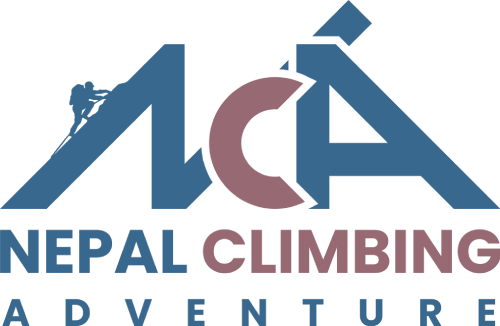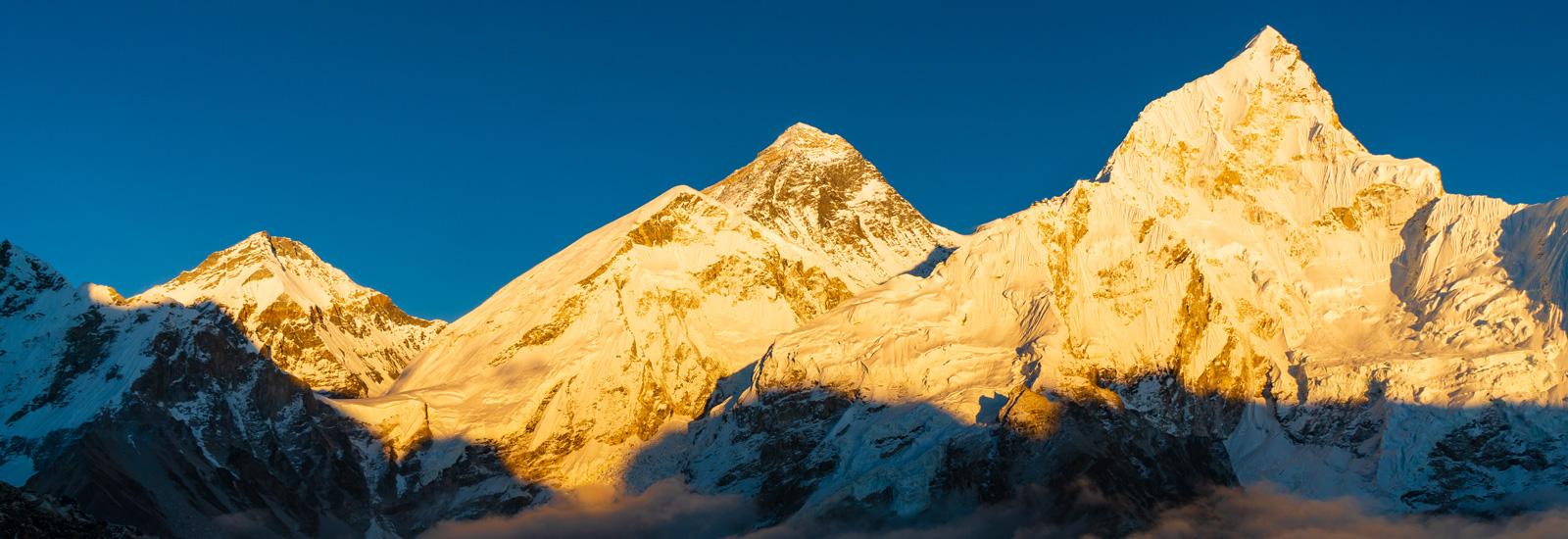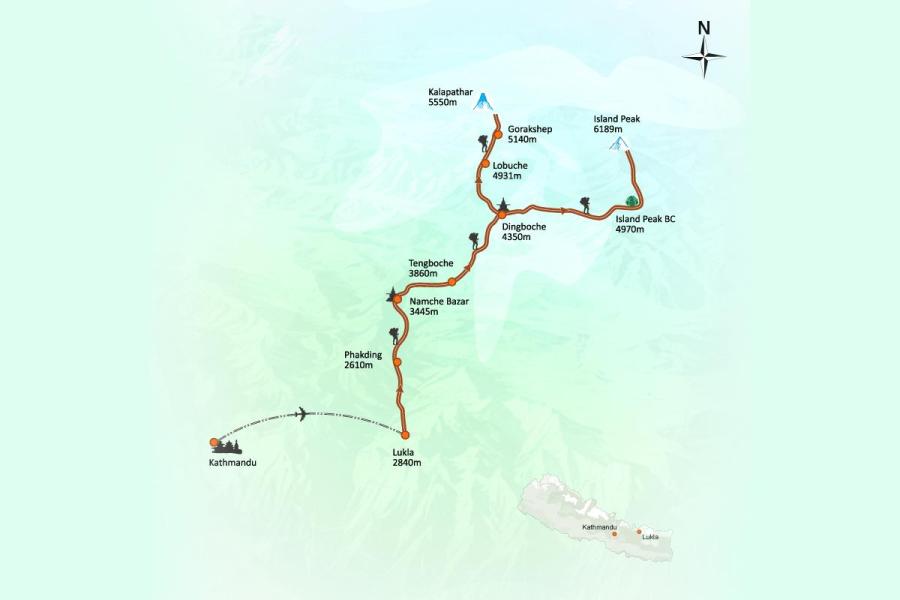Overview:
Have you ever thought of going to the base camp of the highest mountain on earth? If you love trekking, you certainly want to walk there. Everest Base Camp and Kalapathar Trek is one of the most sought-after trekking adventures.
Hundreds of thousand trekkers tread on the trail to the Everest Base Camp every year. The adventure takes you to the magnificent Himalayan region and ultimately to the base camp of Mt. Everest. The Everest Base Camp and Kalapathar trek adventure takes you to the Everest base camp and then to Kalapathar which stands higher than the base camp. You can enjoy the breathtaking panoramic view of the mountains including Mt. Everest.
Trip Information:
The Everest Base Camp trek on the south side, at an elevation of 5,364 m (17,598 ft), is one of the most popular trekking routes in the Himalayas, and about 40,000 people per year make the trek there from Lukla Airport (2,846 m (9,337 ft)).[5] Trekkers usually fly from Kathmandu to Lukla to save time and energy before beginning the trek to the base camp. However, trekking to Lukla is possible. There are no roads from Kathmandu to Lukla and as a result, the only method of transporting large and heavy goods is by plane. Kalapathar trek and the Everest Base Camp trek route follow the given itinerary. You can add or remove days of trek depending on the chosen route.
The Everest Base Camp trek on the south side, at an elevation of 5,364 m (17,598 ft), is one of the most popular trekking routes in the Himalayas, and about 40,000 people per year make the trek there from Lukla Airport (2,846 m (9,337 ft)).[5] Trekkers usually fly from Kathmandu to Lukla to save time and energy before beginning the trek to the base camp. However, trekking to Lukla is possible. There are no roads from Kathmandu to Lukla and as a result, the only method of transporting large and heavy goods is by plane. Kalapathar trek and the Everest Base Camp trek route follow the given itinerary. You can add or remove days of trek depending on the chosen route.
What you see during Everest Base Camp and Kalapathar Trek
The Everest Base Camp Kalapathar trek package brings trekkers the chance to encounter Himalayan magnificence. In addition, you will also experience the cultural riches of the Sherpa community. Exploring the Everest region on foot for twelve days gives you an unforgettable experience that blends culture, nature, and adventure. Everest Base Camp to Kala Patthar distance is approximately 4 km. Kalapathar trek highlights adds extra charm to EBC trek
As you trek through the Sherpa villages in the region, you will learn about the famous Sherpa people and their lives. These people are famous for climbing the mountains. Any Mountaineering Expeditions or Peak Climbing Adventures become successful only because of these amazing Sherpas.
You will see the view of beautiful mountains like Thamserku, Ama Dablam, Lhotse, Lobuche, Everest, Pumori, and several others. The entire mountain range that you will see during the trek will blow your mind away. In addition to the mountains and Sherpa settlements, you will also experience the serenity of nature and the wilderness of high mountains.
Several beautiful monasteries, Mani walls, and prayer flags will add more to the experience.
Reasons this trip becomes an Experience
Nepal Climbing Adventure always strives to offer an adventure traveling experience that you can cherish. While the Everest Base Camp and Kalapathar Trek is beautiful in its all essence, your trekking experience becomes even more beautiful with us. Kala Patthar view of Everest is mesmerizing and fulfilling in itself.
By the time we take you to the base camp and bring you back, we will be one step ahead and offer you a beautiful experience. Our top priority is keeping your safety and happiness, and you will experience the same during the trip.
Trekking with us to Everest Base Camp and Kalapathar is traveling in safe hands.
Highlights of Everest Base Camp and Kalapathar Trek
Here are a few highlights of EBC and Kalapathar Trek.
- Stunning Himalayan Views of Mount Everest (8,848 meters/29,029 feet), the world's highest peak.
- Kalapathar provides one of the best panoramic views of Everest and the surrounding peaks, especially at sunrise and sunset.
- Iconic Landmarks
- Tengboche Monastery in the Khumbu region, is known for its spiritual significance and backdrop of Everest.
- Views of Khumbu Glacier which is one of the world's highest glaciers, located near Everest Base Camp.
- Explore traditional Sherpa culture and hospitality in villages like Namche Bazaar, Phakding, and Khumjung.
- Sagarmatha National Park: A UNESCO World Heritage Site, rich in flora, fauna, and cultural heritage.
- Trek through lush forests, rugged trails, suspension bridges, and high-altitude landscapes.
- Reaching Everest Base Camp height at 5,364 meters (17,598 feet) and Kalapathar at 5,545
- The bustling market town of Namche Bazar is the perfect place for acclimatization and exploring local shops and cafes.
- Spectacular Views of Thamserku and Kongde Ri peaks.
- Watching the sunrise or sunset over Everest from Kalapathar is a memorable experience.
- Enjoy local dishes such as Sherpa stew, momos (dumplings), and authentic Dal Bhat.
Everest Base Camp Trek vs. Annapurna Circuit
Both the Everest Base Camp Trek (EBC) and the Annapurna Circuit Trek are renowned trekking routes in Nepal, each offering unique experiences. Here's a comparative overview:
Everest Base Camp Trek:
The Everest Base Camp trek itinerary usually takes 12-16 days
Route: Kathmandu → Lukla → Phakding → Namche Bazaar → Tengboche → Dingboche → Lobuche → Everest Base Camp → Kala Patthar → Pheriche → Namche Bazaar → Lukla → Kathmandu
Annapurna Circuit Trek:
Annapurna circuit typically takes 15-20 days
Route: Kathmandu → Besisahar → Bhulbhule → Ngadi → Jagat → Dharapani → Chame → Pisang → Manang → Yak Kharka → Thorong Phedi → Thorong La Pass → Muktinath → Jomsom → Pokhara → Kathmandu
|
Aspect
|
Everest Base Camp Trek
|
Annapurna Circuit
|
|
Duration
|
12-16 days
|
15-20 days
|
|
Maximum Altitude
|
Everest Base Camp: 5,364 meters (17,598 feet)
Kala Patthar: 5,644 meters (18,519 feet)
|
Thorong La Pass: 5,416 meters (17,769 feet)
|
|
Scenery and Terrain
|
Spectacular views of Everest and glaciers; varied terrain including forests, meadows, and high-altitude desert
|
Diverse landscapes from subtropical forests to high-altitude deserts; views of Annapurna, Dhaulagiri, and Machapuchare
|
|
Difficulty
|
Moderate to challenging; primarily due to altitude
|
Moderate to challenging; especially for Thorong La Pass crossing
|
|
Accommodation
|
Tea houses and lodges; basic facilities
|
Tea houses and lodges; generally more comfortable and modern facilities
|
|
Cultural Experience
|
Rich Sherpa culture, monasteries, traditional villages
|
Diverse cultures including Gurung, Magar, and Tibetan influences
|
|
Best Time to Trek
|
Spring (March to May) and Autumn (September to November); avoid Monsoon and Winter
|
Spring (March to May) and Autumn (September to November); avoid Monsoon and Winter
|
|
Permit Requirements
|
TIMS card, Sagarmatha National Park permit
|
TIMS card, Annapurna Conservation Area Permit (ACAP), and sometimes a restricted area permit
|
Everest Base Camp and Kala Patthar Trek Difficulty
The Everest Base Camp (EBC) and Kala Patthar trek is a challenging adventure that requires careful preparation.
1. Altitude
- Everest Base Camp: Everest Base Camp trek altitude is 5,364 meters (17,598 feet)
- Kala Patthar: 5,644 meters (18,519 feet)
- Kalapathar trek Difficulty Factor: High altitude increases the risk of altitude sickness. Symptoms can include headaches, nausea, dizziness, and shortness of breath. Proper acclimatization is essential to manage altitude-related challenges.
2. Trekking Duration
- Everest Base Camp and Kalapathar trek duration takes 12-16 days.
- Difficulty Factor: Longer treks require stamina and endurance. The trek involves multiple days of hiking at high altitudes, which can be physically demanding.
3. Terrain
- Lower Altitudes: Lush forests, terraced fields, and river valleys
- Higher Altitudes: Rocky trails, glacier moraines, and alpine meadows
- Difficulty Factor: Terrain can be rugged and uneven, particularly at higher altitudes. Trail conditions can be challenging due to snow or ice.
4. Physical Fitness
- Requirement: Good physical condition is necessary.
- Difficulty Factor: The trek involves long hours of hiking each day. A good level of cardiovascular fitness and stamina is required to handle the daily distances and altitude.
5. Acclimatization
- The altitude sickness for the Everest Base Camp Kalapathar Trekking requires adequate acclimatization days to adapt the body as per the environment.
- Difficulty Factor: Trek itinerary includes rest days to help acclimate. Skipping these rest days or ascending too quickly increases difficulty and health risks.
6. Support and Logistics
- Guides and Porters: Many trekkers use Everest Base Camp and Kalapathar trek guide and porters to carry gear and assist with navigation.
- Difficulty Factor: Using support services can ease the physical burden and logistical challenges, but trekkers still need to be prepared for high altitudes and variable Everest Base camp trek weather.
7. Health and Safety
- Altitude Sickness: Common at high elevations; symptoms can vary from mild to severe.
- Emergency Response: Knowing the signs of altitude sickness and having a plan for emergencies is crucial.
8. Summary of Difficulty
- Overall Difficulty: Moderate to challenging
- Key Challenges: High altitude, variable terrain, and weather conditions
9. Preparation Tips:
- Training: Engage in cardiovascular and strength training to build stamina and endurance.
- Acclimatization: Follow a well-planned itinerary with acclimatization days.
- Gear: Invest in good-quality gear suitable for cold and rugged conditions.
- Health: Stay hydrated, eat well, and listen to your body to manage altitude sickness.
Everest Base Camp and Kalapathar Trek Cost
Kala Patthar trek cost usually depends on several factors like chosen itinerary, acclimatization days and pace of the travelers. The cost consists of permits, fees of guides, porters and meals with traveling medium throughout the trek. This Everest Base Camp and Kalapathar trek cost around $1400 - $1500. This cost can be reduced if you travel with your group. We have several group discounts for the trek to Everest Base Camp and Kalapathar.
Everest Base Camp trek cost and Kalapathar trek cost can be reduced as per the group. Here is the breakdown cost for the group:
|
Group size
|
Cost
|
|
1
|
USD 1490
|
|
2 - 4
|
USD 1400
|
|
5 - 7
|
USD 1250
|
|
8 - 10
|
USD 1150
|
|
11 - 15
|
USD 1000
|
Best Time for Everest Base Camp and Kala Patthar Trek
The best time for Everest Base Camp trek and Kala Patthar is during the two main trekking seasons, which offer the most favorable weather conditions.
Spring (March to May):
During this season, the skies are clear and the weather is stable. It offers a moderate temperature that is ideal for trekking with excellent visibility of the mountains.
The temperature during the spring in the day time is usually 10°C to 15°C (50°F to 59°F) at lower altitudes and at night this temperature falls up to 10°C to -5°C (14°F to 23°F) at higher altitudes. The major advantages of this season are Optimal weather conditions, good visibility, and relatively warmer temperatures.
Autumn (September to November):
During the Autumn Season, the weather in Everest Base Camp Kalapathar expedition offers Clear skies, dry conditions, and stable weather. Temperatures start to drop but are still manageable. Usually, the temperature during the daytime is 5°C to 10°C (41°F to 50°F) at lower altitudes, and in Nighttime it is 15°C to -10°C (5°F to 14°F) at higher altitudes. The major advantages of this season are Stable weather, less crowded compared to spring, and good visibility.
Other Seasons:
Summer (June to August):
During the summer, the Monsoon season comes with heavy rainfall, increased humidity, and potential landslides. Higher altitudes may experience snow and mist. Rain and fog can make trails slippery and reduce visibility. Although the trek cost is usually low and the trail has a lesser number of climbers, It is not recommended due to challenging conditions.
Winter (December to February):
The winter has extremely cold temperatures, snow-covered trails, and high winds. It has several impacts like severe cold and potential snow accumulation that make the Everest Kalapathar Trek very challenging. It is also not recommended for most trekkers due to harsh conditions.
Permits for Everest Base Camp and Kala Patthar Trek
To trek in this region, Everest Base Camp trek permits are required. Here’s a summary of the necessary Everest base camp trek Kalapathar permits:
1. TIMS (Trekkers' Information Management System) Card: It is a permit issued to keep track of trekkers in Nepal and ensure their safety. TIMS cards usually cost USD 10-20, depending on the type and trekking agency handling the application.
2. Sagarmatha National Park Permit
- Purpose: Required to enter and trek in the Sagarmatha National Park, which includes the Everest region.
- Cost: Approximately USD 30 (for foreigners) and around NPR 1,000 (for SAARC nationals).
- Obtained: At the entrance of the Sagarmatha National Park or through a trekking agency.
3. Khumbu Pasang Lhamu Rural Municipality Permit
- Purpose: A new permit required for trekking in the Khumbu region, including Everest Base Camp.
- Cost: Approximately NPR 2,000 (USD 15-20).
- Obtained: At the entry point of the Khumbu region or through a trekking agency.
4. Additional Permits
- For Specific Routes: Some trekking routes or regions may require additional permits or permissions. Check with your trekking agency or local authorities for the most current requirements.
Trek Permits:
- TIMS Card: Required for all trekkers.
- Sagarmatha National Park Permit: Mandatory for entering the park.
- Khumbu Pasang Lhamu Rural Municipality Permit: Required for trekking in the Khumbu region.
FAQ's
Frequently Asked Questions (FAQs)
Is Kala Patthar better than Everest Base Camp?
It's not about what is better, It depends on what the traveler is seeking. Everest Base offers a unique view of the mountain whereas Kalapathar is famous for its sunrise and sunset views. If we talk about elevation, Kalapathar lies at a higher elevation than the base camp which provides it the advantage to see the surroundings with a Birds-eye view.
Is Kalapathar Everest Base Camp Trekking open all year?
Yes! Everest Base Camp is open all year but the best time to get on the trek is during its optimal season. This falls during spring and autumn when the weather is clear and you expect less rainfall in the area.
How long does it take to climb Kala Patthar?
The elevation of Kala Patthar is 5,644 meters (18,176 ft). From Ghorak Shep, the Kala Patthar summit walk takes roughly 2–3 hours. Most tours typically complete the trip early in the morning before descending to Lukla.
What is the difference between the Everest Base Camp trek and the Annapurna Base Camp trek?
The standard Annapurna Base Camp Trek length is 110 km, while the Everest Base Camp is 130 km. So, the Annapurna Base Camp is shorter compared to the Everest Base Camp. However, you can complete both of these treks through different routes, which can alter the number of days you will require to complete these treks.
What are the climatic conditions of Everest Base Camp and Kalapathar Trek?
The climate of Everest Base Camp and Kalapathar trek varies as per the seasons.
- Spring: Everest Base Camp trek weather is generally stable during the spring season.
- Autumn: Stable weather but colder temperatures
- Summer (Monsoon): Increased risk of rain, mud, and landslides
- Winter: Extreme cold and potential snowfall
Is trekking to Everest Base Camp difficult?
The Everest Base Camp Trek is a well-established, safe trek that poses little risk to the average trekker who follows all the preventative guidelines. A bit of preparation will ensure you have a safe trek through one of the most beautiful regions in the world.
Can a normal person climb Everest Base Camp?
Yes! A normal person with average physical condition and prior experience can climb Everest Base Camp. One should be aware of trek routes, rugged paths and acclimatization days.
What is the most difficult part of Everest Base Camp Trek?
The most Difficult part of the EBC trek is Crossing the challenging Cho La Pass. The pass requires proper preparation and dedication to adapt the body to the difficult condition of the trek.
What is the success rate of Everest Base Camp Trek?
The difficulty level of the Everest Base Camp trek has been graded a 'Moderately Difficult' level, and the success rate of the expedition is around 90% depending on the services of the operator you chose.






















